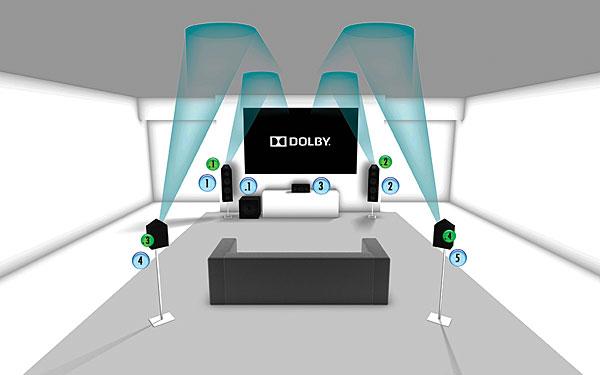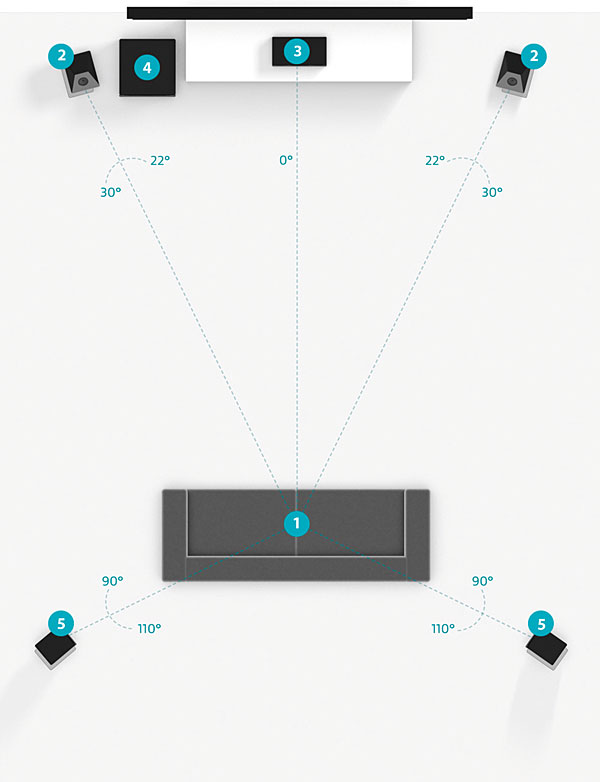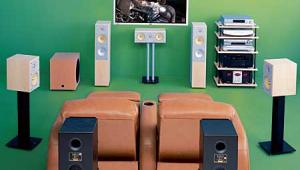Thanks for the detailed comparison. I've been looking for this information for some time. There is also an alternate configuration given in SVS' website (http://www.svsound.com/t/intro-to-atmos). They propose mounting four satellite speakers high up on the front and rear ends of the side walls. It is said that this would meet the angle requirements of in-ceiling speakers. Height speakers are also mentioned in Dolby's website (http://www.dolby.com/us/en/technologies/dolby-atmos/dolby-atmos-home-the...), though in this case they are mounted on the front and rear walls instead of the side walls. Any idea how SVS' proposed setup might perform compared to in-ceiling speakers and Atmos-enabled up-firing speakers?
The Ultimate Test: Dolby Atmos vs. Dolby Atmos

For those who’ve already heard it, Atmos is a significantly uplifting and highly noticeable enhancement over the standard way of doing surround. (Saying it’s the height of movie sound could be a bit over the top, but only if you don’t like puns.) So what’s the best way to add Atmos to your home theater?
Going Atmos
Of course, you’ll need to make some changes to your home theater (in other words, spend some money) to accommodate Atmos. The good news is that your current Blu-ray player will most likely be totally compatible if it’s reasonably modern. The less-than-good news is that you’ll have to add or replace at least two—but preferably four—speakers. (You were probably thinking you needed more speakers anyway, right?) The not-good-at-all news is that your existing AVR or pre/pro will likely have to be replaced with one that includes Atmos processing (though some 2014 models are upgradeable now via firmware).
The additional speakers are the ones that will re-create the “overhead” sound. At a minimum, you’ll need two of these height speakers in the front part of the room. Dolby highly recommends using a second pair of height speakers to extend the effect to the back of the room.
A quick side note on nomenclature: The number of Atmos height speakers a system uses is tacked onto the end of the traditional 5.1 or 7.1 (etc.) designation. Therefore, a 5.1-channel system with two front height speakers is written as 5.1.2 to denote the five traditional core channels (front left/right, center, surround left/right) plus a subwoofer (the .1), plus two height speakers (the .2). You’ll need at least seven channels of amplification (i.e., a 7.1-channel receiver or a seven-channel power amp) to drive everything in a 5.1.2 system but the (likely) powered subwoofer. If you add another pair of height speakers to the back of that system, it’s now a 5.1.4 system, with the need for two more channels of amplification. Likewise for 7.1-and-up systems. Atmos is incredibly flexible, by the way. It’ll handle playback through systems with up to 24 discrete floor (roughly ear-height) speakers, along with up to 10 overhead speakers. In other words, 24.1.10, which is starting to look like an IP address rather than a home theater description.
Is Your Room NSFC (Not Suitable for Ceiling)?
Dolby recommends using in-ceiling or on-ceiling speakers for the overhead or height channels in most rooms. With no proprietary requirements, you can use any standard, off-the-shelf models, as long as they’re full range down to 180 Hz or so, have enough output capability, and have wide dispersion. They should tonally match your main speakers as closely as possible, too. On-ceiling speakers pointing straight towards the floor, perhaps small bookshelf or globe speakers, or thin on-wall-style models, are a functional option—though, as with in-ceiling speakers, they’ll require the hiding of cables behind the ceiling for a clean installation.
There will be cases where ceiling speakers aren’t appropriate, though, because: 1) you don’t want to install ceiling speakers; 2) you can’t install ceiling speakers in the optimum locations; 3) you’ve gone feral and live in a cave with a friendly Sasquatch family; or 4) you’re opposed to ceiling speakers on moral grounds. Regardless, Dolby has another option: Atmos-enabled speakers, which include angled, upward-firing drivers designed to bounce the height channel’s sound off the ceiling and toward the listener. At the moment, companies including Atlantic Technology, Definitive Technology, KEF, Onkyo, and Klipsch make Atmos-enabled add-on speakers that sit on top of your current speakers. Klipsch also makes Atmos-enabled combo speakers with integrated Atmos elevation modules, as do Pioneer and Triad. There will be more of both versions from other companies as time goes on.
Your choices of AVRs and pre/pros with Atmos capabilities are good and growing. As of early June, there were at least 19 AVRs that either include Atmos out-of-the-box or are upgradeable via a firmware update, with the least expensive 7.1-channel models starting at $600 list price. (There are deals to be had out there, too.) Brands currently offering Atmos AVRs include Onkyo, Pioneer, Pioneer Elite, Integra, Denon, Yamaha, and Marantz. You can get a pre/pro with Atmos from Onkyo, Integra, Marantz, Steinway Lyngdorf, and Trinnov, but you’ll need to budget a little more for one of these because they start around $2,500—and remember, you’ll need additional channels of amplification for the overhead channels as well. If you’re on a really tight budget, Onkyo has a couple of home-theaters-in-a-box with limited Atmos capabilities, which you can snag for something in the range of $900 to $1,200.
Where Are the Atmos Blu-rays?
Once you have the hardware, what are you going to watch? By the end of this year, more than 160 movies will have been mixed in Dolby Atmos. That’s great—for the movie theater-goers. But as I write this in early June, there are only eight Blu-ray movies that include an Atmos soundtrack. OK, nine if you count The Expendables 3 as a movie. Ten if you throw in Dolby’s demo disc. (I’m only counting Region 1 BDs here, by the way.) Bizarrely, none of the discs (except for the demo) touts the Atmos soundtrack on its cover. You have to look for the tiny Dolby Atmos logo or find Atmos mentioned in the miniature type of the feature listing. Surely—please, pretty please?—by the time you read this, there’ll be at least a few more Atmos-encoded discs on the market.
You don’t need a new BD player (or new HDMI cables, thank goodness) because Dolby developed a new algorithm and new extensions for Dolby TrueHD and Dolby Digital Plus to include the Atmos encoding while retaining backwards compatibility with non-Atmos gear. A lot of streaming video services use Dolby Digital Plus, which means you can look forward to being able to stream movies with Atmos soundtracks. As a matter of fact, Dolby says that Vudu and Amazon intend to start streaming Atmos-encoded movies; when that’s going to happen, however, hasn’t been announced yet. Go online now, and the only Atmos items you can stream or download from either provider are Dolby demo clips. (Yeah, baby, demo clips!)
Go Take a Height
Dolby has fairly specific guidelines concerning when to use in-ceiling or Atmos-enabled speakers, as well as where to install or place whichever type of speaker you use. If you’re upgrading your system yourself, download Dolby’s Dolby Atmos Home Theater Installation Guidelines white paper. It includes lots of very informative diagrams showing recommended angles, layouts, and install positions. In the meantime, I’ll quickly talk you through the basics.


To begin with, unlike a speaker system’s center and surround back channels, Atmos speakers are always added in pairs. If you’re only able to use one pair of overhead speakers, they should always be used for the front overhead channels. It’s OK to mix speaker types, if appropriate, by using a pair of ceiling speakers for the front overheads and a pair of Atmos-enabled up-firing speakers for the rear overheads—or vice versa. (Mixing left and right speaker types, on the other hand, is very, very not OK.) Note that your AVR or pre/pro will send a somewhat different signal to your ceiling speakers or Atmos-enabled elevation modules depending on the type used, to ensure they provide the optimum effect.
In an average room with a typical 8- to 14-foot-high ceiling, Dolby says the preferred setup uses ceiling speakers. In a four-overhead-speaker setup, you’d install the front pair of ceiling speakers between the listener and screen, and place the rear ceiling speakers slightly behind the listener. In a system with only two overhead speakers, you’ll mount them in the front of the room, but ideally in somewhat closer proximity to the listener than if you had two pair of height speakers (see diagrams). For most speakers that have a reasonably wide dispersion pattern, they should be firing straight down. But if you’re stuck using speakers designed with a more narrow dispersion pattern, and they feature “aimable” drivers, Dolby recommends directing them at the listener. The locations of the remaining listener-level speakers in a 5.1.4, 7.1.4, or 9.1.4 system stay roughly the same.


When you use Atmos-enabled combo speakers or Atmos-enabled add-on modules, speaker placement is nearly identical to the standard arrangements for 5.1, 7.1, and so on, though if your existing surrounds are mounted much above ear level, you may want to consider lowering them a bit to ensure enough distinction between side/back and ceiling effects. The front left and right Atmos-enabled speakers simply replace your current front speakers. When you use add-on modules, ideally they should be placed on top of the existing front speakers. The back pair of Atmos-enabled combo speakers (or add-on elevation modules) for a 5.1.4 system should replace (or sit on top of) your original in-room surround speakers. In 7.1.4 and 9.1.4 systems, the Atmos speakers (or modules) should replace (or sit on top of) the surround back speakers.
Confused? Don’t sweat it, because now we’re going to move on to the less-convoluted topic of the equipment I used.
Atmos.2 or Atmos.4?
As I’ve mentioned, Dolby says using ceiling speakers is the preferred setup—for most rooms. In some cases, they note, “experts” have found that Atmos-enabled speakers sound just as good. By virtue of the fact that there’s essentially no labor involved in setting up Atmos speakers or add-on modules (other than running an extra set of speaker wires), it’ll usually be cheaper and easier to go the in-room route, rather than the in-ceiling path. What we wanted to find out was just how audible the differences are among the various setups. How much surround sound or basic sound quality, if any, do you sacrifice if you use Atmos-enabled rather than ceiling speakers? For that matter, what’s the difference between using only two front height speakers versus four? We also thought it would be cool to discover just how time-consuming and confusing it could be to compare all these variations.
- Log in or register to post comments


Does this object oriented imaging just work for discrete acoustical images like knives, planes, bullets, etc, or will Atmos reproduce height ambience in music recordings?

So I tested the TMNT scene in Chapter 11 with the Shredder mentioned here and there is absolutely zero sound in the height channels during the knives sequence. There's plenty of sound in the heights in other sequences, but I'm not sure what kind of difference you were hearing in this particular scene but it couldn't be from the number of type of height channels because there's nothing coming from them whether you have 2, 4 or 24 height channels.

My home theater room has a finished ceiling and installing speakers means a lot of work and money. I decided as an experiment to connect a set of speakers to the height channels and just set them on speaker stands temporarily. I've listened to at least 4 different Atmos sources and it seems to me that there is almost no sound that ever comes out of the height speakers. I'm using a Yamaha RX-A850 receiver and I'm 99% positive everything is setup correctly, I'm pretty good with this stuff.
Based on my experiment I can't see the point in spending thousands of dollars to install ceiling speakers and re-drywall. Weird, as I expected so much more....there must be something wrong with the setup???

The TMNT example used here was a bad example of Atmos IMO. Now, I've conducted the same test with movies like Blade Runner 2049 or Ready Player One and there is a TON of stuff going on in the height channels. I currently only have two and am debating on adding two. IMO, it worth it once set up properly, which is why I was so shocked to read this article that seemed to articulate Atmos so well only to find one of the examples used actually had no sound coming from the height channels.

Thanks for the feedback. I actually own Blade Runner 2049 but never tested that movie, I'll try it and see.

Start by conducting thorough research to create a shortlist of potential roofing service providers. Utilize online directories to find roofing contractors in your area. Many Roofing contractors Woodlands TX reputable contractors have professional websites that showcase their services and customer reviews.

I used the Shredder that was specified here to test the TMNT scenario from Chapter 11, and during the knives sequence, the height channels do not produce any sound at all. Regardless of whether you have 2, 4, or 24 height channels, there is no audible difference in this scene compared to others. I'm not sure what you mean by "heights," because in other sequences there is plenty of sound in the heights.
mapquest driving directions

When participating in traffic, you need complete attention and absolute concentration to ensure safety. Let us suggest this to you mapquest driving directions

I like to explore myself through games, where I feel confident to win. How about you, have you ever played this game Papa's freezeria? I think it's quite cool and engaging and I love playing fun games like this.

The front overhead Atmos speakers should be positioned between the listener and the screen. In a typical setup with four overhead speakers, the front pair is installed directly above the listening area, while the rear overhead speakers are placed slightly behind the listener. This positioning helps create an immersive sound experience, ensuring that the audio effectively envelops the listener from above @slope run

This is my best purchase for https://www.cctv717 as of the moment.

She is not alone. Indians lost over 1,200m rupees to “digital arrest” hoaxes between January and April this yeardames gummy co
prime time grape
lady boss strain
super nuken strain
grape prime time
buy exotic carts online
nexus full flavor cigarettes
burt reynolds strain
trippy flip chocolate
willo gummies review
thechronfather
the chron father
dames gummy co
magic mango gummies
exotic carts
magic mango weed gummies
diamond concentrates gelato
dames gummy co reviews
lemon sour diesel
unicorn hunter pen



















































